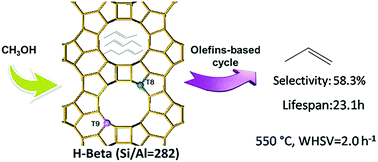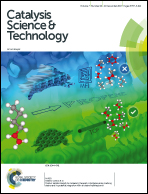Investigation of methanol conversion over high-Si beta zeolites and the reaction mechanism of their high propene selectivity†
Abstract
Large pore high-Si beta zeolites (Si/Al = 136 to 340) were synthesized by a HF-assisted method, and their catalytic performance for the conversion of methanol to propene was explored. It is demonstrated that beta zeolites with low acid density facilitate the achievement of high propene selectivity and a high propene/ethene ratio. The HF dosage in the synthesis has great influence on the Al distribution in the framework, as evidenced by 27Al MAS NMR and 27Al MQ MAS NMR spectroscopy, which may influence the acidity and microstructure of acid sites and lead to a remarkable catalytic lifespan. A HF/SiO2 ratio of 0.45 is found to facilitate the synthesis of high-Si beta enriched with Al atoms located at the T9 sites; this helps the catalyst show the longest lifetime, with a propene selectivity of 49.7–58.3% at 550 °C and WHSV = 2 h−1. With the aid of 12C/13C-methanol switch experiments, we elucidated that the olefin-based mechanism dominates the reaction and contributes to the formation of ethene, propene, and higher olefins. Moreover, two phenol compounds are identified in the coke species, which have not been observed previously and have been found to be detrimental to the reaction.

- This article is part of the themed collection: 2017 Catalysis Science & Technology HOT Articles


 Please wait while we load your content...
Please wait while we load your content...